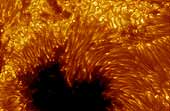|
COMETS EARTH JUPITER KUIPER BELT MARS MERCURY METEORITES NEPTUNE OORT CLOUD PLUTO SATURN SOLAR SYSTEM SPACE SUN URANUS VENUS ORDER PRINTS
PHOTO CATEGORIES SCIENCEVIEWS AMERICAN INDIAN AMPHIBIANS BIRDS BUGS FINE ART FOSSILS THE ISLANDS HISTORICAL PHOTOS MAMMALS OTHER PARKS PLANTS RELIGIOUS REPTILES SCIENCEVIEWS PRINTS
|
Related Documents
Download Options
Part of the largest sunspot in Active Region 10030 recorded on 15 July 2002 with the Swedish 1-m Solar Telescope on La Palma. This image was post-processed with the so-called Phase-Diversity Technique, making it the highest-resolution solar image ever. The tickmarks around the edge of the image is there to show the scale. The distance between two ticks is 1000 km. The central part of the sunspot ("the umbra") looks dark because the strong magnetic fields there stop upwelling hot gas from the solar interior. The thread-like structures surrounding the umbra make up the penumbra. Dark cores are clearly visible in some of the bright penumbral filaments that stick out into the umbra.
Credit Statement Accompanied With The ImagesThe following statement was taken from the Royal Swedish Academy of Sciences web page.All images are free for publication. Please credit the Royal Swedish Academy of Sciences unless personal credit information is stated for a particular image. Here is the name of the academy in a couple of languages: Swedish: Kungl. Vetenskapsakademien. German: Die Königlich Schwedische Akademie der Wissenschaften. French: L'Académie Royale des Sciences de Sučde. Spanish: Real Academia de Ciencias de Suecia. |
